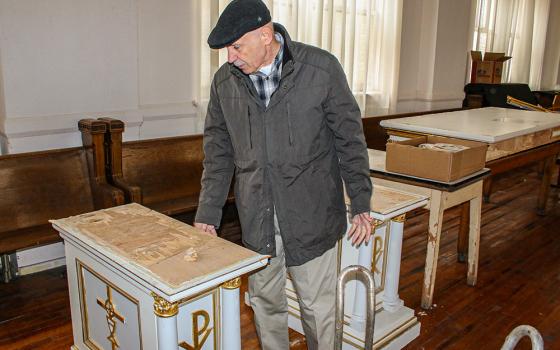
Letters to the editor from all over the globe were received at NCR in response to an opinion piece published Dec. 18 titled "Is sipping from the Communion cup a hazard to your health?" The article was written by Jesuit Fr. Thomas S. Acker, Ph.D., the administrator at St. Joseph Parish in Randolph, Ohio, and Brian Cain, M.D., a parishioner there and a family practitioner for 27 years. The following letters have been edited for length and clarity.
***
My email is in response to your recent article: "Is sipping from the Communion cup a hazard to your health?"
I was excited to read that intinction has been approved in the United States. I wanted to know the details, so I read Norms for the Distribution and Reception of Holy Communion under Both Kinds in the Dioceses of the United States of America.
This is what it says about the distribution of the body and blood of Christ in this manner: "If this modality is employed, however, hosts should be used which are neither too thin nor too small, and the communicant should receive the Sacrament from the Priest only on the tongue."
Therefore, the methods suggested by the author, having the communicant do the intinction, do not appear to be approved by the U.S. bishops.
I would appreciate clarification of this discrepancy. I am a eucharistic minister and would like to see intinction in our parish.
MARY LYNCH
St. Simons Island, Georgia
***
I have no problem with all the medical facts presented in the article. I will, however, draw your attention to an important fact: In Lourdes, every person going for a bath in the water emanating from the miraculous stream is dunked in the same water. This has gone on for decades.
Some of those people have had virulent diseases. There have been no complaints. Maybe there is a lot of faith in the miracle of the waters at Lourdes.
Maybe we could do with some of that faith in the miracle of the Eucharist.
(Br.) A. L. NORONHA
India
***
Intinction is an option here and more than half of communicants use it, but though I hesitate to argue with a medical Ph.D., some reported tests about the time Communion from the chalice was restored showed that most germs die instantly on contact with gold — a good argument and possibly the only one, for using a gold or gold-plated chalice.
What chemists class as the precious metals all have this property and it is more marked the heavier the element. Still, there is a type of water filter for use in poor countries that uses it: a traditional clay pot, with the base unglazed and clay of (at least) the base containing traces of colloidal silver, i.e the smallest possible solid particles, suspended in water. Water seeping through the porous clay impregnated with these particles is thus disinfected. The inventor was a potter in Puerto Rico; the idea is spreading around the world.
I admit that the Communion wine does not come into quite such intimate contact with a gold chalice and that people living in an aseptic environment may not have such good natural immunity. Here, it takes a cholera outbreak to discourage the minority who sip.
(Fr.) BRIAN MACGARRY, SJ
Mbare, Zimbabwe

***
A very sensible article. My synagogue has a similar problem, around both bread and wine for its communal "kiddush" after Saturday service. But something doesn't make sense:
"As a medical doctor for over 27 years and in family practice, I never drink from the cup unless I am the first after the priest."
I don't understand this rule. Is the priest somehow immune from catching, and transmitting, viruses? Or will his viruses not infect laypeople?
CHARLES COHEN
Richmond, British Columbia, Canada
***
As a practicing pharmacist (32 years), I am disappointed the anecdotal events offered do not demonstrate cause and effect. Our societies have numerous examples of well-intended "helpful health practices." However their scientific basis is dubious.
The viral and/or bacterial episodes presented could equally be the result of numerous fomites, the edges of the pews, door handles, etc. Also the incubation period for various communicable infections (as noted) would also make it challenging to subscribe the communal chalice as the proximal cause of an upper respiratory illness. In addition any pathogen that may be contracted orally is neutralized in the highly acidic gastric contents.
Myself and other eucharistic ministers from our parish always wipe the chalice between those receiving — as such cross contamination is very remote. It is for these reasons it is not necessary to suspend exchanging the sign of peace be that a handshake or respectful embrace.
Perhaps we should have faith in our creator who is pleased when we share in his body and blood.
JOHN FONTAINE
Forest, Ontario, Canada
***
Under no circumstances would I drink from a communion cup, and I do not understand why U.S. parishes do not dip the host into the wine.
When I was in Rome in 2013, while Pope Francis was being installed, I received Communion at the convent where I was staying. The celebrant was a cardinal, and he dipped the host into the wine. So does Pope Francis when he distributes Communion. For years I had been told that was not permissible. Still waiting for U.S. parishes to do what the pope does.
PENNY JEFFREY
Parma Heights, Ohio
***
Regarding "Is sipping from the communion cup a hazard to your health?" I am reminded of a fellow catechist who was greatly antagonistic when I told the First Communion class that, due to my poor health, I did not always receive in both forms. She was insistent that "Sister always said" the miracle of the sacrament prevented any disease transmission, making my choice and my explanation something close to heresy.
I have often wondered how many alcoholics, celiac sufferers and those with weakened immune systems have compromised their health through unquestioned faithfulness to what "Sister said."
BETH HIMES
Glendale, Ohio
***
Thank you for including in the article on sipping from the cup that receiving communion on the tongue is not hygienic. Would that every minister who places eucharist on someone's tongue sanitize their hands before distributing to the next person.
MARTY MEYER-GAD
Mankato, Minnesota
***
Authors Jesuit Fr. Thomas S. Acker and Brian Cain are wrong to say that drinking from the communion cup is a hazard to your health. They offer only anecdotal evidence. What real data we have says drinking from the cup is OK or, at least, no worse than shakings hands or opening the church front door.
See these excerpts from three studies:
The hazard of infection from the shared communion cup: "No episode of disease attributable to the shared communion cup has ever been reported. Currently available data do not provide any support for suggesting that the practice of sharing a common communion cup should be abandoned because it might spread infection."
Risk of Infectious Disease Transmission from a Common Communion Cup: "In summary, the risk for infectious disease transmission by a common communion cup is very low, and appropriate safeguards-that is, wiping the interior and exterior rim between communicants, use of care to rotate the cloth during use, and use of a clean cloth for each service-would further diminish this risk."
Debunking The Communion Cup Myth: "In other words, you're more likely to contract germs on the door handle leading into church or shaking someone's hand after the service than on the lip of a Communion cup."
ROBERT V. SCAVULLO
San Francisco, California
**
While the authors make good points about not participating when you are ill (and some people not having the good sense not to participate in this case), overall, this issue has been discussed and researched more fully than their anecdotal experiences. Please note the following reference to the American Journal of Infection Control:
However, a recent study of 681 persons found that people who receive Communion as often as daily are not at higher risk of infection compared with persons who do not receive communion or persons who do not attend Christian church services at all.
In summary, the risk for infectious disease transmission by a common communion cup is very low, and appropriate safeguards that is, wiping the interior and exterior rim between communicants, use of care to rotate the cloth during use, and use of a clean cloth for each service-would further diminish this risk. In addition, churches may wish to consider advising their congregations that sharing the communion cup is discouraged if a person has an active respiratory infection (ie, cold or flu) or moist or open sores on their lips (eg, herpes).
As an active eucharistic minister for the past 35 years, and a communicant multiple times per week, of average health, and often the last person to drink from the cup from which I am administering, my experience holds with that of the above-cited study. I have never been noticeably ill after serving, and never experienced any number of possible infectious diseases, even after repeated and prolonged exposure to this practice.
As a pastoral associate, I also train ministers to wipe and turn the cup after each use, and to open and use different areas of the purificator used for wiping. With a little practice, this is a simple, barely perceptible movement. Yes, common sense should dictate that persons who are ill should not approach the cup, nor should persons with compromised immune systems. Accordingly, the number of those who approach the cup usually decreases a bit in the winter months when colds and flu are common.
For now, I will confidently continue to receive from the cup.
JENNIFER MARRAN
Kingston, Rhode Island
***
I've been a monk for nearly 50 years and priest for over 40 years.
I find the subject article written by Jesuit Fr. Thomas Acker and Brian Cain is most interesting. While I do not doubt their conclusion, there is another side to the issue. What about those who do not receive communion from the cup, nor in the hand, but insist on receiving communion on the tongue? Yet they barely open their mouths with the resulting deposit of saliva on the priest's or communion ministers' fingers. The saliva gets deposited on the hand or mouth of the next communicant. I find this also unacceptable and I have the tendency to tell the communicant(s) to "Open your mouth and stick out your tongue!"
Although I have been criticized for this on occasion, I continue to do so.
(Fr.) AARON S. PETERS, O.S.B.
Atchison, Kansas
***
I read your article detailing the issue of becoming sick after receiving the precious blood of Christ at Communion. If we Catholics truly believe that the host is the body of Christ and the cup of wine truly the blood of Christ then what pathogen can survive in the cup? After all it has now become the body, blood, soul and divinity of our Lord Jesus Christ through the consecration actions of the priest as taught in faith formation.
We must always remember that Satan will introduce the slightest doubt as to the properties of the blessed sacrament and the effects cause this type of hysteria. As a eucharistic minister I not only consume the sacred blood of Christ, but also purify the vessels and drink the combined mixture of all the cups used in Mass and have never once become ill.
TED PEREZ
Mesquite, Texas
***
The concern for the health of parishioners expressed by Jesuit Fr. Thomas and Brian Cain in their article on the safety of sharing the Communion cup is laudable. Alas, their understanding of the sacrament is not: what they have written represents the most unfortunate, dated and fundamentalist writing about the eucharist.
The authors, for example, write twice of "receiving the Precious Blood" as if the consecrated wine in the cup, and the consecrated bread on the altar, are not each the fullest sign of the risen Lord in his complete, glorified existence present to us. Worse, they insist that the custom of intinction "doubles the number of persons receiving both (my emphasis) the Body and Blood of the Lord."
This is shocking: as any Catholic high school student can tell you, the body and blood of the risen Jesus in the Eucharist (the whole person in his glorified existence) is entirely present in one or both species. The error is compounded when the article refers to "a small ring of the Precious Blood" left in the cup or elsewhere. I haven't heard this kind of unfortunate language since Catholic grade school 70 years ago. It might have been pardonable then; it surely cannot be so now.
This essay is grist for the mills of those who indict Catholics for cannibalism. The authors write as if St. Thomas Aquinas and the Council of Trent — not to say even the most conservative sacramental theology since the turn of the 20th century — had never put quill pen to parchment. I'm astonished and sad that the NCR would publish so backward (not to say frightening and theologically dated) an essay by writers who surely should have known better.
DONALD SPOTO
Borup, Denmark
Advertisement
***
I take exception to the commentary regarding receiving from the cup. Are you certain you are a Catholic? Not once do you refer to the cup as the blood of Christ, not once.
I consider it a matter of trust and faith to take the Lord's body and blood at Communion. I never receive if I am ill, it is common courtesy, because I don't want to infect the eucharistic minister, but I still have a strong enough belief in the blood of Christ to not worry about receiving Communion in both forms. Where is your faith in Jesus' blood and body?
JO ANN ALLEN-SIEGERT
Wickenburg, Arizona
***
I've read and reread the article by Jesuit Fr. Thomas Acker and Brian Cain about fears about the Communion cup. Why such scare tactics? Has the CDC retracted their earlier remarks/study about this? If so, why wasn't that mentioned in the article?
Also, receiving a host on the tongue is an action that far more easily spreads germs than receiving in the hands (contact with saliva). And there was no mention of the biggest offender: door handles.
Rarely a year goes by when someone doesn't come up with yet another reason to forego use of the cup. Why add to the clatter?
RICK REED
Huntsville, Texas
***
I was wondering what the author of the concerns about drinking from the cup feels about a handshake for the sign of peace in winter. Is that cause for health concerns?
JIM O'NEILL
Lawrence, Massachusetts
***
Thank you for this article which makes me ask some questions about transubstantiation which I studied in theology class at a Catholic college many years ago. We learned that at the moment of consecration of the host, it's because the body of Christ and was no longer bread. Same for the wine — it was no longer wine but the blood of Christ.
Why could we pick up any disease if we are truly receiving the blood of Christ? The alcohol would not have to "kill" any possible germs. Why would an alcoholic priest have to use non-alcoholic wine if he is no longer drinking wine but the blood of Christ which, of course, would contain no alcohol? Has there ever been a scientific procedure to test the bread and wine before the consecration and after the consecration to see if, indeed, there is a difference? If there is no difference what are we to believe?
Catholics are taught to believe that we are receiving the body and blood of Christ and it not just symbolic. If this is true, why wouldn't Catholics be better people and act in better ways?
MARY ALICE BABKA
Ashburn, Virginia
Join the Conversation
Send your thoughts and ideas, reactions and responses to letters@ncronline.org. The editor will collect them, curate them and publish a sampling in Letters to the Editor online or in our print edition.
We cannot publish everything. We will do our best to represent the full range of letters received. Here are the rules:
- Letters to the editor should be submitted to letters@ncronline.org.
- Letters to the editor should be limited to 250 words.
- Letters must include your name, street address, city, state and zip code. We will publish your name and city, state, but not your full address.
- If the letter refers to a specific article published at ncronline.org, please send in the headline or the link of the article.
- Please include a daytime telephone number where we can reach you. We will not publish your phone number. It may be used for verification.
- We can't guarantee publication of all letters, but you can be assured that your submission will receive careful consideration.
- Published letters may be edited for length and style.



